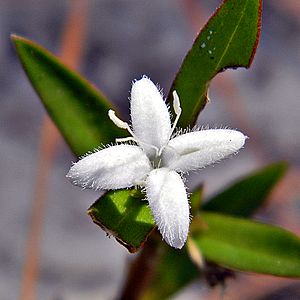Virginia buttonweed facts for kids
Quick facts for kids Virginia buttonweed |
|
|---|---|
 |
|
| Scientific classification |
Virginia buttonweed, also known by its scientific name Diodia virginiana, is a common plant. It belongs to the Rubiaceae family, which includes many types of flowering plants. This plant often spreads out and forms a dense mat on the ground.
What Does Virginia Buttonweed Look Like?
Virginia buttonweed has leaves that grow opposite each other on the stem. Sometimes, these leaves look spotty or discolored. This can happen because of a tiny virus that affects the plant. The flowers of Virginia buttonweed are white and shaped like a cross, with four petals. Its fruits are green and can often float on water.
Where Does Virginia Buttonweed Grow?
This plant is native to several places, including Cuba, Nicaragua, and Mexico. In the United States, you can find it in Connecticut and across the south-central and southeastern parts of the country. It grows in every state along the Gulf and Atlantic coasts, from Texas all the way to New Jersey. You can also find it in the Tennessee and Ohio River Valley areas, and in the southern Great Plains. Virginia buttonweed has also spread to other countries like Japan and Taiwan, and it grows in northern California.
Why Can This Plant Be a Nuisance?
Virginia buttonweed can sometimes become a problem plant, often called a "weed." It's hard to get rid of because it has parts that grow underground. When you try to pull the plant up, these underground pieces often break off and stay in the soil. This means the plant can easily grow back, making it a challenge for gardeners and farmers to control.

